

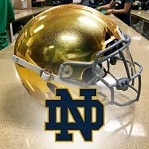








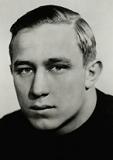
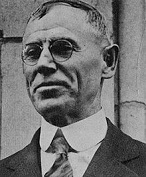













TLW's College Footballscope™ (College Football Historyscope) |
By T.L. Winslow (TLW), the Historyscoper™ |
© Copyright by T.L. Winslow. All Rights Reserved. |
Original Pub. Date: Sept. 15, 2018. Last Update: Sept. 17, 2018. |
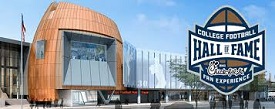
Westerners are not only known as history ignoramuses, but double dumbass history ignoramuses when it comes to College Football. Since I'm the one-and-only Historyscoper (tm), let me quickly bring you up to speed before you dive into my Master Historyscope.
On Nov. 6, 1869 teams from the Rutgers U. (State U. of N.J.) (formerly Queen's College) and Princeton U. (College of N.J. unti 1896) meet in New Brunswick, N.J. for the first Intercollegiate Football Game, which Rutgers wins by 6 to 4; there are 25 players per team (reduced to 11 in 1880), with a spherical ball, each score counting as a game, and the contest consisting of 10 games; the ball could be advanced only by kicking or batting it with the feet, hands, head, or side; after each score, teams change direction.
In 1873 U.S. football clubs the adopt uniform Harvard Rules.
On May 14, 1874 the first internat. Harvard (Boston) Rules rugby football game is played at Jarvis Field in Cambridge, Mass. between Harvard U. of the U.S. and McGill U. of Montreal, Canada; Harvard wins by 3-0; on May 15 they play again under McGill rugby rules, ending in a 0-0 tie after McGill uses a leather-covered bladder instead of a round rubber ball like Harvard; next June 4 Harvard and Tufts play under McGill rules, which is won by Tufts, with each side playing 11 men, establishing the modern version of college football, which turns the rugby try into the football touchdown (TD) and features tackling.
On Nov. 13, 1875 the Harvard Crimson and Yale Bulldogs football teams meet for the first time, with Harvard winning 4-0, becoming an annual contest known as The Game, the first athletic rivalry in Am. intercollegiate athletics; Walter Camp is among the 2K spectators, and enrolls at Yale next year, bringing Harvard's style of play with him; ditto for Princeton; in 1876 Harvard freshman Theodore Roosevelt attends the 2nd game, uttering the soundbyte: "In life as in football, the principle to follow is hit the line hard", waxing lyrical on football's "manly virtues", becoming football's savior in the early 20th cent.
On Nov. 30, 1876 (Thur.) the Princeton football team plays Yale in New York City on Thanksgiving, starting a tradition (ends 1882).
On Sept. 29, 1882 the U. of Minn. Golden Gophers football team plays its first game, defeating Hamline U. 4-0; in 1890 they defeat the rival U. of Wisc. Badgers 63-0.
On Nov. 30, 1882 (Thur.) (Thanksgiving) after Yale and Princeton tie 0-0 for the last 3 years, the student-run Intercollegiate Football Assoc. holds its first Thanksgiving Day Championship Game, starting a tradition.

In 1887 the Notre Dame Fighting Irish football team has its first season, going on to win 11/13/21 nat. championships, seven Heisman Trophy winners, 101 consensus All-Americans, 52 College Football Hall of Fame members, 13 NFL Hall of Fame members, 495 players selected by the NFL Draft (#2 after USC), and hold the highest all-time win percentage in college football (0.729) and 2nd most wins (908); starting in 1991 all its home games are televised by NBC-TV, becoming the only school; players wear navy jerseys and cool golden helmets.
On Mar. 14, 1889 Harvard introduces spring practice to collegiate football.

In 1889 Yale U. football coach (captain of the 1878 and 1879 Yale football teams) ("Father of Am. Football") Walter Chauncey Camp (1859-1925), known for attending every important rule committee meeting until his death and for revising the rules of football initiates the practice of naming the best college football players each season for the College Football All-American Team, and popularizing All-Am. teams with Caspar Whitney via articles in This Week's Sports mag. and Collier's mag. In 1891 he pub. American Football.
On Nov. 29, 1890 (first Sat. after Thanksgiving) the first Army-Navy Football Game is played in West Point between the Army Black Knights and Navy Midshipmen; Navy defeats Army by 24-0; starting in 1899 games are played mainly in Philly; in 2009 it is moved to the 2nd Sat. in Dec., becoming the last non-bowl contest in college football each year.

On Mar. 11, 1892 the first public game of Basketball is played in the Springfield, Mass. YMCA in front of a crowd of 200; the student team defeats the faculty team 5-1; "Grand Old Man of Football" Amos Alonzo Stagg (1862-1965) scores the only faculty basket, then later this year becomes head football coach at the U. of Chicago (until 1932), lasting 41 seasons, incl. five undefeated, winning 314 games as a coach; he goes on to introduce the huddle, man-in-motion, and the end-around play, and invent the batting cage in baseball.
On Sept. 28, 1892 the world's first Night Am.-Rules Football Game is played in Mansfield, Penn. by teams from Mansfield State Normal School (later Mansfield U.) and Wyoming Seminary of Kingston, Penn., using the newfangled electric lights, but they are so dim that it ends after 20 min. and 10 plays at halftime with a 0-0 tie after several players run into a light pole; there are no names or numbers on uniforms, and the ball is larger and rounder than modern-day footballs, resembling a basketball with laces.
On Nov. 19, 1892 Harvard U. plays football against Yale U. in Springfield, Mass., introducing the Flying Wedge at the start of the 2nd half in place of the usual Princeton V (V Trick).
In 1895 the Big Ten Conference (B1G) (originally the Western Conference) is founded by seven teams in the NCAA's Division 1 incl. the U. of Chicago, U. of Ill., U. of Mich., U. of Minn., Northwestern U., Purdue U., and the U. of Wisc., expanding to 14 colleges and 28 sports (14 men's, 14 women's), becoming the oldest Div. 1 college athletic conference in the U.S.
In 1895 Spalding's Official Football Guide begins pub., ed. (until 1924) by Walter Chauncey Camp (1859-1925), who was first called "the Father of Am. Football" in 1892 by Caspar Whitney (1862-1929) in Harper's Weekly, going on to turn it into a game of crazy, er, heroes that captures the Am. imagination.

In 1895 Glenn Scobey "Pop" Warner (1871-1954) becomes head football coach at the U. of Ga. (until 1896), launching a 44-year career at Cornell U. (1897-8, 1904-6), Carlile Indian Industrial School in Penn. (1899-1903, 1907-14) (where he coaches Jim Thorpe), the U. of Pittsburgh (1915-23), Stanford U. (1924-32), and Temple U. (1933-8), achieving 319 major NCAA college football wins and four nat. championships (1915, 1916, 1918, 1926).
The original Never On A Sunday? On Jan. 1, 1902 (Wed.) the first Rose Bowl (originally the Tournament East-West Football Game) is held; Mich. defeats Stanford by 49-0; the next one isn't held until 1916; it is always held on Jan. 1 unless it's a Sun., when it is held on Mon. Jan. 2; the Stanford Cardinal team was originally organized by Herbert Hoover when he was a freshman.

In 1903 Kentland, Ind-born playwright George Ade (1866-1944) pub. College Widow, the first play about Am. football, about the rivalry between Atwater College and Bingham College; star halfback Billy forsakes Bingham to play for Atwater to be near his babe Jane, daughter of the pres.; made into the 1917 Broadway musical "Leave It to Jane" by Jerome Kern, Guy Bolton, and P.G. Wodehouse.

On Oct. 9, 1905 after Harvard U. pres. (1869-1909) Charles William Eliot (1834-1926), ed. of the Harvard Classics, known for turning Harvard into an internat. research univ. and giving blacks W.E.B. DuBois et al. opportunities comes out in opposition to college football, calling it "a fight whose strategy and ethics are those of war", where "the weaker man is considered the legitimate prey of the stronger", concluding "no sport is wholesome in which ungenerous or mean acts which easily escape detection contribute to victory", causing The New York Times, Harper's mag., McClure's mag., and Nation mag. to back him up, calling for reform or outright abolishment of the sport, Pres. Theodore Roosevelt holds a meeting at the White House with Walter Camp, Bill Reid, and Arthur T. Hillebrand representing Yale, Harvard, and Princeton, talking them into saving the sport via rule changes; too bad, on Nov. 25 19-y.-o. Union College halfback Harold Moore is knocked-out in a game against NYU and dies of a cerebral hemorrhage six hours later, causing NYU pres. Henry MacCracken to call for protective headwear for athletes, and the Cincinnati Commercial Tribune to run the cartoon "Grim Reaper Smiles on the Goalposts" on Dec. 3, becoming known as football's first concussion crisis; on Dec. 28 after two White House conferences convened by Pres. Theodore Roosevelt to "encourage reforms" in college football to prevent injuries and deaths, followed by a meeting of 13 U.S. colleges and univs. organized by NYU chancellor Henry MacCracken, a meeting of 62 higher education institutions appoints the Am. Football Rules Committee, which convenes next Jan. 12, banning the flying wedge, creating the neutral zone, and increasing the distance for a first down from 5-10 yards; next Mar. 31 they form the Intercollegiate Athletic Assoc. of the U.S. (IAAUS), which changes its name to the Nat. Collegiate Athletic Assoc. (NCAA) in 1910; in 1921 it conducts the first NCAA nat. championship, the Nat. Collegiate Track and Field Championships; in 1939 it conducts its first basketball championship; meanwhile failing to abolish football, lame retro Eliot goes after baseball, basketball, and hockey, uttering the soundbyte: "I understand that a curve ball is thrown with a deliberate attempt to deceive. Surely this is not an ability we should want to foster at Harvard" - since I got in the loop I can see the future?
In 1906-10 U.S. football games are played on fields marked with 5-yd. checkerboard lines.
On Dec. 5, 1908 the U. of Pittsburgh becomes the first football team to use uniform numbers.


On Nov. 23, 1912 the first Neb. U.-Okla. U. football game, played in Lincoln Neb., is won by Neb. 13-9; the longest win streak is 16 by Okla. in 1943-58; the largest victory is Neb. by 69-7 in 1997; the last game is played in Norman, Okla. on Dec. 4, 2010, with Okla. winning by 23-20, leading the series 45-38-3; the next meeting will be in Norman, Okla. on Sept. 18, 2021.



In 1912 Dwight David Eisenhower (1890-1969) of West Point injures his knee trying to tackle James Francis "Jim" Thorpe (1888-1953) of Carlisle Indian Industrial School of Carlisle, Penn. in a football game, which Carlisle wins by 27-6; Thorpe's coach from 1907-14 is Glenn Scobey "Pop" Warner (1871-1954).
On Nov. 1, 1913 Notre Dame stuns Army 35-13 at West Point as QB Gus Dorais debuts the forward pass to running back Knute Rockne, beginning a rivalry with the Army to add to the rivalry with Mich. State U.
On Dec. 2, 1915 the Pacific Coast Conference is formed by UCB, U. of Wash., U. of Ore., and Ore. State College, later adding Washington State College, Stanford U., U. of Idaho, USC, U. of Mont., and UCLA; after a major scandal involving a slush fund it is disbanded on June 30, 1959, after which the Pac-12 Conference is founded, growing to 12 members participating in 24 sports in NCAA Div. I incl. U. of Ariz., Ariz. State U., UCB, UCLA, U. of Colo. Boulder, U. of Ore., Ore. State U., USC, Stanford U., U. of Utah, U. of Wash., and Wash. State U.


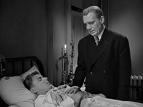
On Dec. 14, 1920 Notre Dame U. football star (#66) (1917-20) George "Gipper" Gipp (1895-1920) dies in South Bend, Ind. of pneumonia; on his deathbed he tells coach (1918-30) Knute Kenneth Rockne (1888-1931) "Sometime when the boys are up against it and the pressure's really on Notre Dame, tell them to win one for the Gipper"; he once ran the 100 yards in 10.2 sec. in full uniform, and has a contract to play baseball for the Chicago Cubs. On Nov. 10, 1928 Notre Dame defeats Army 12-6 at Yankee Stadium after Coach Knute Kenneth Rockne (1888-1931) gives his famous halftime Win One for the Gipper Speech, repeating the deathbed words of star Notre Dame player (#66) George "Gipper" Gipp (1895-1920): "The last thing George said to me, 'Rock', he said, 'Sometime when the team is up against it and the breaks are beating the boys, tell them to go out there with all they've got and win just one for the Gipper'"; Gipp is portrayed by Ronald Reagan in the 1940 film Knute Rockne, All American.
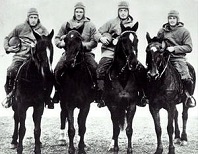
In 1922 the Notre Dame Fighting Irish football team backfield from 1922 to the Rose Bowl game of 1925 gains legendary status as the Four Horsemen, incl. QB Harry Augustus Stuhldreher (1901-65), HB Don "Midnight" Miller (1902-79), HB James Harold "Jim" Crowley (1902-86), and FB Elmer Francis Layden (1903-73).
On Oct. 18, 1924 Notre Dame football team (coach Knute Rockne) becomes famous not only for its Four Horsemen but its Seven Mules (linemen), with a 9-0 record, incl. a 13-7upset of Army at the Polo Grounds in N.Y., with sports writer Grantland Rice writing "the most famous football lead of all-time": "Outlined against a blue-gray October sky, the Four Horsemen rode again. In dramatic lore their names are Death, Destruction, Pestilence, and Famine. But those are aliases. Their r eal names are: Stuhldreher, Crowley, Miller and Layden. They formed the crest of the South Bend cyclone before which another fighting Army team was swept over the precipice at the Polo Grounds this afternoon as 55,000 spectators peered down upon the bewildering panorama spread out upon the green plain below."


On Jan. 1, 1925 9-0 Notre Dame defeats 7-0-1 Stanford by 27-10 to win the 1925 Rose Bowl, becoming the last ride of the Four Horsemen; Ernest Alonzo "Ernie" Nevers (1903-76) rushes for 114 yards, more than the Four Horsemen combined, and is named MVP, causing him to be compared to Jim Thorpe, and Pop Warner to call him "the football player without a fault"; Nevers signs as a pitcher with the St. Louis Browns next year, gives up two homers to Babe Ruth in his 1927 60-homer season, then is signed by Red Grange to the NFL, saving it from bankruptcy; in 1929 he scores 6 TDs and kicks four extra points (40 points total) for the Chicago Cardinals against the Chicago Bears. On Nov. 21, 1925 3-time All-American college star Harold Edward "Red" Grange (1903-91), "the Galloping Ghost" plays his last football game for the U. of Ill., and joins the Chicago Bears less than a week later on Thanksgiving Day for the unheard-of sum of $100K, saving the NFL from oblivion as avg. game attendance at Wrigley Field zooms to 10K; too bad, he leaves to form his own Am. Football League in 1926 with his team called the New York Yankees, but it folds in one season, and he returns to the Bears in 1929-34.
On Dec. 4, 1925 the first USC-Notre Dame Football Game is won by Notre Dame 13-12, beginning a rivalry; in 1952 the Jeweled Shillelah Trophy is introduced, with a ruby-adorned Trojan added for each USC victoy, and an emerald-studded shamrock added for each Notre Dame victory; it runs out of space after the 1989 game,
On Dec. 26, 1925 the first East-West Shrine Football Game for college seniors is played in San Francisco, Calif.; West defeats East by 6-0; proceeds go to the Shrine's Hospital for Crippled Children; the motto is "Strong Legs Run That Weak Legs May Walk"; meanwhile on Feb. 6 the NFL adds a rule making college players ineligible to play until their college class graduates.
In 1926 Bennie Russell, son of Benjamin Russell, owner of men's long underwear maker Russell Athletic in Alexander City, Ala. (founded 1902) invents the Sweatshirt while playing football at the U. of Ala. in Tuscaloosa.

On Sept. 25, 1927 Millard Webb's silent B&W film The Drop Kick (First Nat. Pictures) debuts, based on the story "Glitter" by Katherine Brush, starring Richard Barthelmess as college football player Jack Hamill, Barbara Kent as Cecily Graves, and Hedda "nobody's interested in sweetness and light" Hopper as Mrs. Hamill, becoming the cameo debut of actor ("The Duke") Marion Mitchell (Robert) Morrison (John Wayne) (1907-79), who got his start throwing leaves into a fan for dir. John Ford and once mistakenly barged into the camera to sweep them up, causing Ford to see his potential?
On Dec. 8-9, 1932 the Southeastern Conference (SEC) is founded for NCAA Div. 1 college sports teams in the U.S. South, incl. the U. of Fla., U. of Ga., U. of Ky., U. of Mo., U. of S.C., Vanderbilt U., U. of Alabama, U. of Ark., Auburn U., La. State U., U. of Miss., Miss. State U., Texas A&M U., Ga. Inst. of Tech., Tulane U., and the U. of the South; in 2013 it founds the SEC Network.


In 1935 the first Heisman Memorial Trophy (given to recognize "the most valuable college football player east of the Mississippi") is awarded by the Downtown Athletic Club of New York City to "one-man football team" John Jacob "Jay" Berwanger (1914-2002) of the U. of Chicago, who gave future U.S. pres. Gerald Ford (U. of Mich. center) a permanent scar below his left eye last year; in 1936 he becomes the first player drafted by an NFL team, the Philadelphia Eagles, and ends up using the trophy as a doorstop in his library; after the club's Cleveland, Ohio-born athletic dir. John William Heisman (b. 1869) ("pioneer of Southern football") dies on Oct. 3, 1936, the award is broadened to incl. players W of the Mississippi.
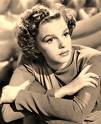
On Oct. 23, 1936 David Butler's Pigskin (Harmony) Parade debuts, starring Jack Haley as Texas State U. football coach Winters, who saves the struggling team with Ark. hillbilly Stuart Erwin, the best passer of all time; the feature film debut of Judy Garland (Frances Ethel Gumm) (1922-69) from Grand Rapids, Mich., who is named by George Jessel after Carole Lombard's char. Lily Garland in the 1934 film Twentieth Century, and by Frances after a popular Rudy Vallee song; lesbian actress Patsy Kelly plays Haley's wife Bessie; features Garland singing The Balboa.

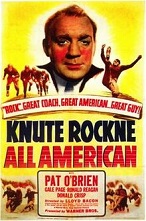


On Oct. 4, 1940 Lloyd Bacon's and William K. Howard's Knute Rockne: All American (Warner Bros.) debuts, becoming the major film debut of Ronald Wilson Reagan (1911-2004), and his signature performance as Notre Dame U. football star "The Gipper" George Gipp (1895-1920), who dies in hospital room #23; Pat O'Brien plays Notre Dame coach Knute Rockne, uttering the immortal soundbyte: "Tell the boys to win one for the Gipper", which is deleted from the TV airing of the film after the Gipp family files a lawsuit. On Jan. 26, 1940 Hollywood actor Ronald Wilson Reagan (1911-2004) marries actress Jane Wyman (Sarah Jane Mayfield) (1917-2007) (until June 28, 1948) in Wee Kirk o' the Heather Church in Forest Lawn, Calif.; they have one adopted son, Michael (b. 1945) and two daughters, Christine (born and died on June 26, 1947), and Maureen Reagan (1941-2001).
In 1945 the Ivy Group Agreement of the Council of Ivy Group Presidents incl. Nathan Pusey of Harvard and A. Whitney Griswold of Yale adopted, containing the soundbyte about football teams that "The players be truly representative of the student body and not comprised of a group of special recruited and trained athletes"; in 1954 the Ivy League is created, incl. Harvard U., Yale U., Brown U., Columbia U., Cornell U., Dartmouth College, Princeton U., and U. of Penn., extending the Ivy Group Agreement to all sports.

In 1951 the College Football Hall of Fame is planned for Rutgers U. in New Brunswick, N.J., site of the first intercollegiate football game with Princeton U.; too bad, no bldg. is built until 1978 in Kings Mill, Ohio near Kings Island, which closes in 1992; on Aug. 25, 1995 a new bldg. opens in South Bend, Ind., and closes in 2012; on Aug. 23, 2014 a $68.5M 94,256 sq. ft. football-shaped bldg. opens in Atlanta, Ga. next to the Centennial Olympic Park and Ga. Tech.
In 1953 the Atlantic Coast Conference (ACC) is founded in Greensboro, N.C. by the NCAA's Div. 1; members incl. the U. of N.C., Duke U., U. of Md., N.C. State U., Wake Forest U., U. of Va., Clemson U., Georgia Tech U., Fla. State U., Virginia Tech, Boston College, and U. of Miami.
On Nov. 23, 1957 Yale skunks Harvard in football by 54-0, becoming the worst skunking since their 28-0 win on Dec. 1, 1945, their 28-0 win on Nov. 24, 1900, and their 52-0 win on Nov. 22, 1884; in 1897-1912 one team skunks the other, except for 0-0 ties in 1897, 1899, 1910, and 1911.
On Nov. 23, 1968 after both teams go 8-0 (first time both teams go unbeaten and untied since 1909), the 1968 Yale vs. Harvard Football Game at Harvard Stadium ends in a 29-29 tie after Harvard makes a miraculous comeback, scoring 16 points in the final 42 sec. with Yale leading 29-13, scoring a TD and 2-pt. conversion to make the score 29-21, after which Yale dittos to make the final score 29-29, causing the Harvard Crimson to print the headline "Harvard Beats Yale, 29-29"; too bad, after this game rule changes eliminate ties from college football.
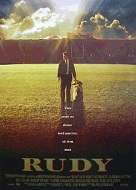
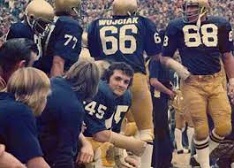
On Oct. 15, 1993 David Anspaugh's Rudy (TriStar Pictures) debuts, starring Sean Astin as Daniel Eugene "Rudy" Ruettiger (1948-), a 5'7" 165 lb. runt who overcame every obstacle to play football for the U. of Notre Dame as defensive end #45, scoring a sack against Georgia Tech on Nov. 8, 1975 and getting carried off the field; Jon Favreau plays D-Bob, Charles S. Dutton plays Fortune, and Ned Beatty plays daddy Daniel Ruettiger Sr.; does $22.8M box office on a $12M budget; View clip.
On Feb. 25, 1994 the Big 12 Conference is founded for NCAA Div. 1 sports teams (except hockey) from the merger of the Big Eight Conference, with Oklahoma U., Oklahoma State U., Texas U., Texas A&M, Texas Tech, and Baylor U. becoming known as the Big 12 South, and Kansas U., Kansas State U., Colo. U., Nebraska U., Mo. U, and Iowa State U. becoming known as the Big 12 North, joining the ACC, Big 10, Pac-12, and SEC as one of the Power Five Conferences.
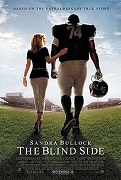
On Nov. 20, 2009 John Lee Hancock's The Blind Side (Warner Bros. Pictures) debuts, based on the 2006 book by Michael Lewis debuts, starring Sandra Bullock as wealthy white Memphis, Tenn. mother Leigh Anne Tuohy, who takes big black homeless Michael "Big Mike" Oher (Quinton Aaron) and adopts him, molding him into a pro football offensive left tackle and 2009 first round NFL draft pick for the Baltimore Ravens after conquering his academic problems with the help of tutor Miss Sue (Kathy Bates); Tim McGraw plays hubby Sean Tuohy, and Jae Head plays cute son Sean "S.J. Tuohy Jr.; grosses $256M in the U.S. (#8) and $309.2M worldwide on a $29M budget.